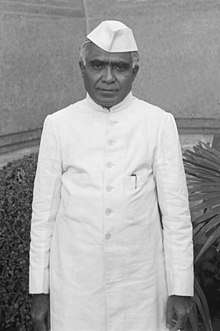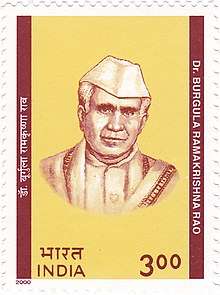Burgula Ramakrishna Rao
Dr. Burgula Ramakrishna Rao (13 March 1899 – 15 September 1967) was the first elected Chief Minister of the erstwhile Hyderabad State. Prior to the independence of India and the political integration of the princely states into the Union, he was among the Telugu-speaking leaders to resist the Nizam in the princely state of Hyderabad.[1]
Dr. Burgula Ramakrishna Rao | |
|---|---|
 Rao in 1952 | |
| 4th Governor of Uttar Pradesh | |
| In office 1 July 1960 – 15 April 1962 | |
| Preceded by | V. V. Giri |
| Succeeded by | Biswanath Das |
| 1st Governor of Kerala | |
| In office 22 November 1956 – 1 July 1960 | |
| Succeeded by | V. V. Giri |
| Chief Minister of Hyderabad State | |
| In office 1952–1956 | |
| Personal details | |
| Born | Pullamraju Ramakrishnarao 13 March 1899 Padakallu Village, Kalwakurthy, Hyderabad State |
| Died | 15 September 1967 (aged 68) |
| Nationality | India |
Early life
Burgula Ramakrishna Rao was born in a Telugu Brahmin family in Padakallu village, Kalwakurthy taluk in Mahbubnagar district. Though his surname was Pullamraju, he would be more popularly known among the Telugu people by his village name, Burgula. He was educated at the Dharmavanth and Excelsior High School in Hyderabad, where he would receive a B.A. (Honours) degree from Fergusson College, Pune and a law degree from Bombay University in 1923.
Career
He received famous “Allies” scholarship and graduated in law in Mumbai and took up the legal profession in Hyderabad but continued for a few days only. After meeting Madapati Hanumantha Rao, Burgula dedicated his life for public service and to popularize science and literature. He was imprisoned twice for participating in public movements. He gave up law portfolio given by Mirza Ismail, the Dewan (Prime Minister) of Hyderabad State.
Burgula was a great humanist, stood against injustice, and declared war on the dictatorship of Nizam along with Swami Ramananada teertha in order to support the public. A litterateur, social reformer, statesman, linguist, he laid the foundation for cultural development of and political spirit in the Telangana region which was oppressed under the Nizam. He was one of the founding members of the Hyderabad State Congress. He presided over the second Andhra Mahasabha conference at Devarkonda in 1932 and gave direction for Telangana society. He also worked as a secretary for Hyderabad Swadesi League and Nizam Subjects League. He was also involved in promoting the library movement in the State.
Imroze news paper was launched by Ramakrishna Rao and his brother Ranganatha Rao to be a voice of the Congress and Communists from his own house.
Burgula played a crucial role in restoring stability for the people of Telangana following the campaign of terror led by the Razakars, who were loyalists to the Nizam, responsible for carrying out meticulously organized atrocities throughout Hyderabad State. Burgula served as Revenue Minister in the cabinet of Vellodi government (1950) which was formed after the Indian Army easily routed the Nizam's regular forces during the liberation of Hyderabad by India.
Burgula Ramakrishna Rao played a crucial role in many contemporary movements and laid a firm foundation for the cultural development and independent political spirit for the people of Telangana who had been oppressed under the reign of the Nizam. He was a prime witness to Telangana's struggle for freedom, its library movements, the Telangana farmers’ struggle and the Vishalandhra movements. He deserted areas of work where the atmosphere was polluted. He worked as a Revenue Minister in the cabinet of Vellodi government (1950) which was formed after police action. He got victory from Shadnagar constituency in the first sovereign elections held in 1952, and became the first Chief Minister of Hyderabad. After the termination of Nizam rule, in a short period he formed a stable democratic system with his administrative skill. He eradicated the system of jagirdar and mukthedar in Telangana and introduced the law of tenancy and became the first Indian land reformer. Until then education was in Urdu medium in Telangana and for the first time he gave importance for teaching in native language.
The services of Burgula spread not only in Telangana but also to neighbouring areas. After the formation of Andhra Pradesh in 1956, as a Governor of Kerala state, he showed his statesmanship and got acclaim from many top politicians. When he was Governor of Uttar Pradesh, he was elected as a member of Rajya Sabha in 1962 and gave up politics in 1967.
Burgula was an eloquent speaker of English, Farsi, Urdu, Sanskrit, Marathi, Kannada and Telugu. Despite being a lawyer by profession, his love for language and literature was everlasting. He wrote poems, essays and translated books even the master pieces of Adi Shankaracharya.
Burgula established "Young Man Union" with the support of friends and relatives when he was studying Inter. Under the control of this Union, he established a library and brought the spirit of reading and speaking in public by giving speeches on different societal issues. In 1921, to form a responsible government and to bring political reforms in Hyderabad, he prepared a statement with the help of Madapati Hanumantha Rao and Ranga Rao on reforms (State Reform Association). He published many essays in English newspapers against the social evil dowry.
Due to his prominent role in the Quit India Movement in 1942, and again for his participation in the freedom struggle in 1947, he was arrested by the Nizam's police. K.M. Munshi, the then Agent of India in Hyderabad State, spoke of his great contribution to the timely 'Police Action' by India against the Nizam, who ultimately surrendered to the Indian forces on 17 September 1948. He took several significant steps for the welfare of the people, including the historic 'land reforms' in the State. The passage and implementation of the famous Hyderabad Tenancy and Agricultural Act of 1950, followed in 1954 by Hyderabad Tenancy and Agricultural lands (Amendment) Act, was an important signpost of land reforms in the country. Dr. Rao not only provided the conceptual framework for these Acts but also piloted their passage and vigorously pushed through their implementation, providing tenancy rights to those who had been cultivating lands for some time.
From November 1956 to July 1960, Dr. Ramakrishna Rao was the Governor of Kerala and later Governor of Uttar Pradesh till April 1962. He was later elected to the Rajya Sabha. In which he served from 1962 to 1966. He died on 14 September 1967.
Birth centenary celebrations
The birth centenary celebrations of Dr. Burgula Ramakrishna Rao were held under the auspices of the Government of Andhra Pradesh from 13 March 1999 to 13 March 2000. Andhra Pradesh Chief Minister, N. Chandrababu Naidu, inaugurated the centenary celebrations, and a commemoration stamp of this great leader was released by the Department of Posts, Government of India, on 13 March 2000. The Prime Minister, Atal Behari Vajpayee, released the biography of this great leader on 31 August 1999 at Raj Bhavan, Hyderabad.
Dr. Burgula's versatility was truly amazing and he stood like a colossus among the leaders of his time and carved out a niche for himself as a multi-faceted personality.
Personal life
Burgula Ramakrishna Rao was married firstly to Smt. Radha Bai and later to Mrs. Ananthalakshmi Devi and is survived by his son, Burgula Lakshmi Narayana Rao.[2] His parents were Sri Narsing Rao and Mrs. Ranganayakamma and his younger brother was the late Sri Venkateshwara Rao.
His eldest son late Shri Burgula Ranganatha Rao died in 2008 and Shri Lakshmi Narayana Rao is his only surviving child. He is also survived by his grandsons, Burgula LakshmiKanth, Burgula Sai Ramakrishna, and Burgula Pavan Kumar. Shri late Ranganatha Rao has four surviving daughters Mrs. Jayadevi, Mrs. Vasumathi, Mrs. Radha and Mrs. Prabhavathi. Dr Illindala Prabhakara Rao, Padmaja, Sharada are his grand children born to his eldest daughter late Mrs. Syamala Devi. He is survived by Mrs. Aruna, daughter of the eldest daughter Indira of Mrs. Ananthalakshmi Devi.
Commemorations

A gold medal was instituted for meritorious student in Humanities (Philosophy) at Sri Sathya Sai Institute of Higher Learning by Sathya Sai Baba himself. A gold medal for meritorious students in all disciplines of engineering at JNTU Hyderabad was instituted by his son Lakshmi N Rao and grandsons Sai R Krishna, Pavan kumar.
A statue in his memory, instituted by Shri N Chandrababu Naidu, was erected at the Greater Hyderabad Municipal Corporation office in Hyderabad. The BRKR Government Offices Building was instituted by Shri N.T. Rama Rao, the then Chief Minister of Andhra Pradesh.
The leadership of Shri T. Anjayya saw the establishment of the Dr. BRKR Government Ayurvedic College in the S.R. Nagar suburb of Hyderabad. It is the premier institution in the state of Telangana for the academic discipline of Ayurveda.
See also
- 1951–52 elections in India
- List of Chief Ministers of Andhra Pradesh
References
- "The Hindu : Briefly". Hinduonnet.com. 14 March 2004. Retrieved 3 December 2010.
- "Andhras taking my father's name for selfish reas". The New Indian Express. 19 December 2009. Retrieved 3 December 2010.
External links
| Wikimedia Commons has media related to Burgula Ramakrishna Rao. |